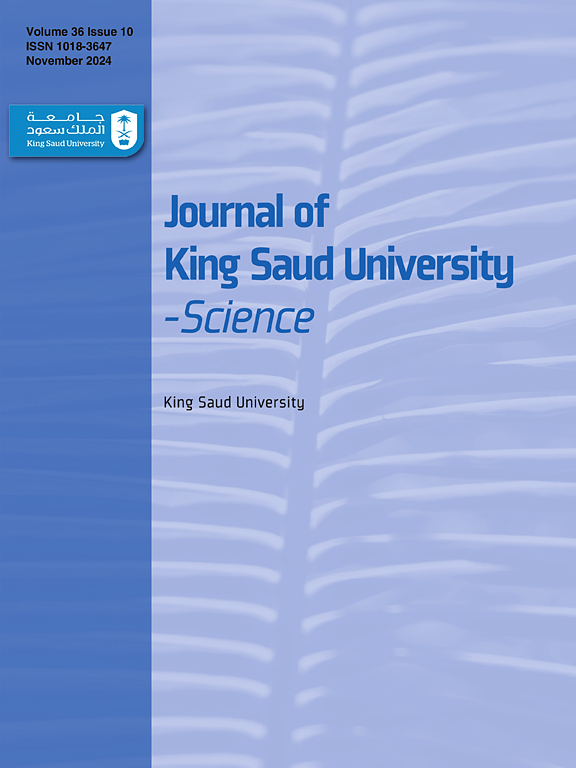Phytochemicals of Withania coagulans (Stocks) Dunal against androgen receptor: An in silico insight
IF 3.6
3区 综合性期刊
Q1 MULTIDISCIPLINARY SCIENCES
引用次数: 0
Abstract
Objectives
The androgen receptor is considered a magic target due to its involvement in multiple pathways leading to several maladies and its accessibility for small molecules to bind to it and modulate its normal functioning. The phytochemicals from the plant, Withania coagulans (Stocks) Dunal (common name: Rishyagandha) with traditional practice in healing different diseases were investigated in this regard. The higher safety profile and cost-effective features of plant-based resources in the design and development of drug like candidates seems to be worthy of exploration in the realm of alternate therapeutic options.
Methods
Several computational methods involving flexible receptor molecular docking calculations and molecular dynamics simulations were carried out. Spatially and thermodynamically stable adducts with best docking scores were identified using various parameters extracted from the molecular dynamics trajectory to find the hit candidates capable of inhibiting or disrupting the normal functioning of the target protein leading to the cure of the disease. The server based ADMET prediction was performed to comprehend the druglikeness, bioavailability, and toxicity profile of different phytochemicals.
Results
The molecule, 24-Methyl-9,19-cyclolanost-25-en-3-ol (PubChem CID: 185036) showed the binding score of −10.726 kcal/mol against androgen receptor (PDB ID: 1E3G) better than that of the native ligand, 17-β-hydroxy-17-methylestra-4,9,11-trien-3-one (PubChem CID: 261000) with −10.268 kcal/mol and selected anticancer drugs (best value of -10.080 kcal/mol for darolutamide). Withacoagulin I (PubChem CID: 71720665) displayed the binding score of −10.108 kcal/mol and was considered the second top molecule. The stability of the protein-phytochemical adducts as calculated from 200 ns long molecular dynamics simulations revealed good geometrical intactness from multiple spatial descriptors (root mean square deviation, radial pair distribution function, and hydrogen bond distribution) and sustained thermodynamical spontaneity from binding free energy changes of the protein-ligand complexes. The pharmacokinetics and pharmacodynamics showed acceptable druglike properties, good bioavailability and safety comparable with that of the reference drugs.
Conclusions
The hit molecules could be considered as possibly capable of inhibiting the target protein that would perform as anticancer agents and are recommended for further experimental trials for the verification of theoretical inferences.

凝固剂对雄激素受体的植物化学作用:基于计算机的研究
雄激素受体被认为是一个神奇的靶点,因为它参与了导致多种疾病的多种途径,并且小分子可以与它结合并调节它的正常功能。在这方面,研究人员调查了来自植物Withania coagulans (Stocks) Dunal(通用名称:Rishyagandha)的植物化学物质,这些植物具有治疗不同疾病的传统做法。基于植物的资源在设计和开发候选药物方面具有更高的安全性和成本效益特征,似乎值得在替代治疗选择领域进行探索。方法采用柔性受体分子对接计算和分子动力学模拟等计算方法。利用从分子动力学轨迹中提取的各种参数,确定具有最佳对接分数的空间和热力学稳定的加合物,以找到能够抑制或破坏靶蛋白正常功能的候选命中物,从而治愈疾病。采用基于服务器的ADMET预测来了解不同植物化学物质的药物相似性、生物利用度和毒性。结果24-甲基-9,19-环烷醇-25-烯-3-醇(PubChem CID: 185036)对雄激素受体(PDB ID: 1E3G)的结合得分为- 10.726 kcal/mol,优于天然配体17-β-羟基-17-甲基-4,9,11-三烯-1 (PubChem CID: 261000)与选定抗癌药物的结合得分为- 10.268 kcal/mol(达洛鲁胺的最佳值为-10.080 kcal/mol)。Withacoagulin I (PubChem CID: 71720665)的结合分数为−10.108 kcal/mol,被认为是第二大分子。通过200 ns长的分子动力学模拟计算得到的蛋白质-植物化学加合物的稳定性表明,多种空间描述符(均方根偏差、径向对分布函数和氢键分布)具有良好的几何完整性,蛋白质-配体配合物的结合自由能变化具有持续的热力学自发性。其药代动力学和药效学表现出可接受的类药特性,具有良好的生物利用度和与参比药物相当的安全性。结论hit分子可能具有抑制靶蛋白的作用,可作为抗癌药物,建议进一步进行实验验证理论推断。
本文章由计算机程序翻译,如有差异,请以英文原文为准。
求助全文
约1分钟内获得全文
求助全文
来源期刊

Journal of King Saud University - Science
Multidisciplinary-Multidisciplinary
CiteScore
7.20
自引率
2.60%
发文量
642
审稿时长
49 days
期刊介绍:
Journal of King Saud University – Science is an official refereed publication of King Saud University and the publishing services is provided by Elsevier. It publishes peer-reviewed research articles in the fields of physics, astronomy, mathematics, statistics, chemistry, biochemistry, earth sciences, life and environmental sciences on the basis of scientific originality and interdisciplinary interest. It is devoted primarily to research papers but short communications, reviews and book reviews are also included. The editorial board and associated editors, composed of prominent scientists from around the world, are representative of the disciplines covered by the journal.
 求助内容:
求助内容: 应助结果提醒方式:
应助结果提醒方式:


